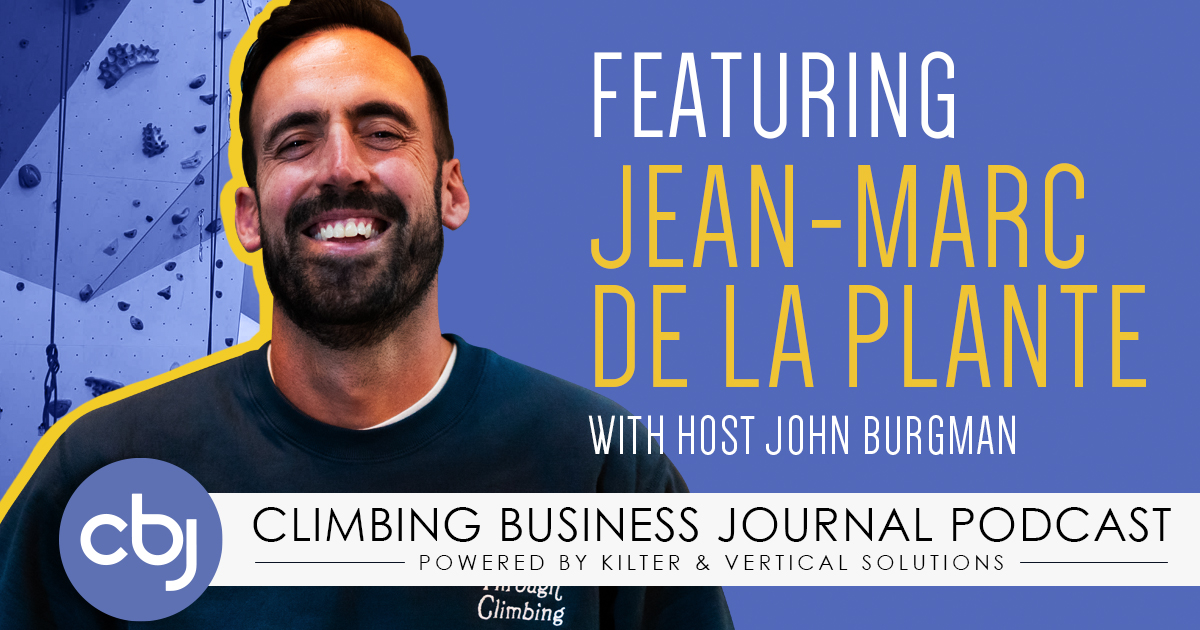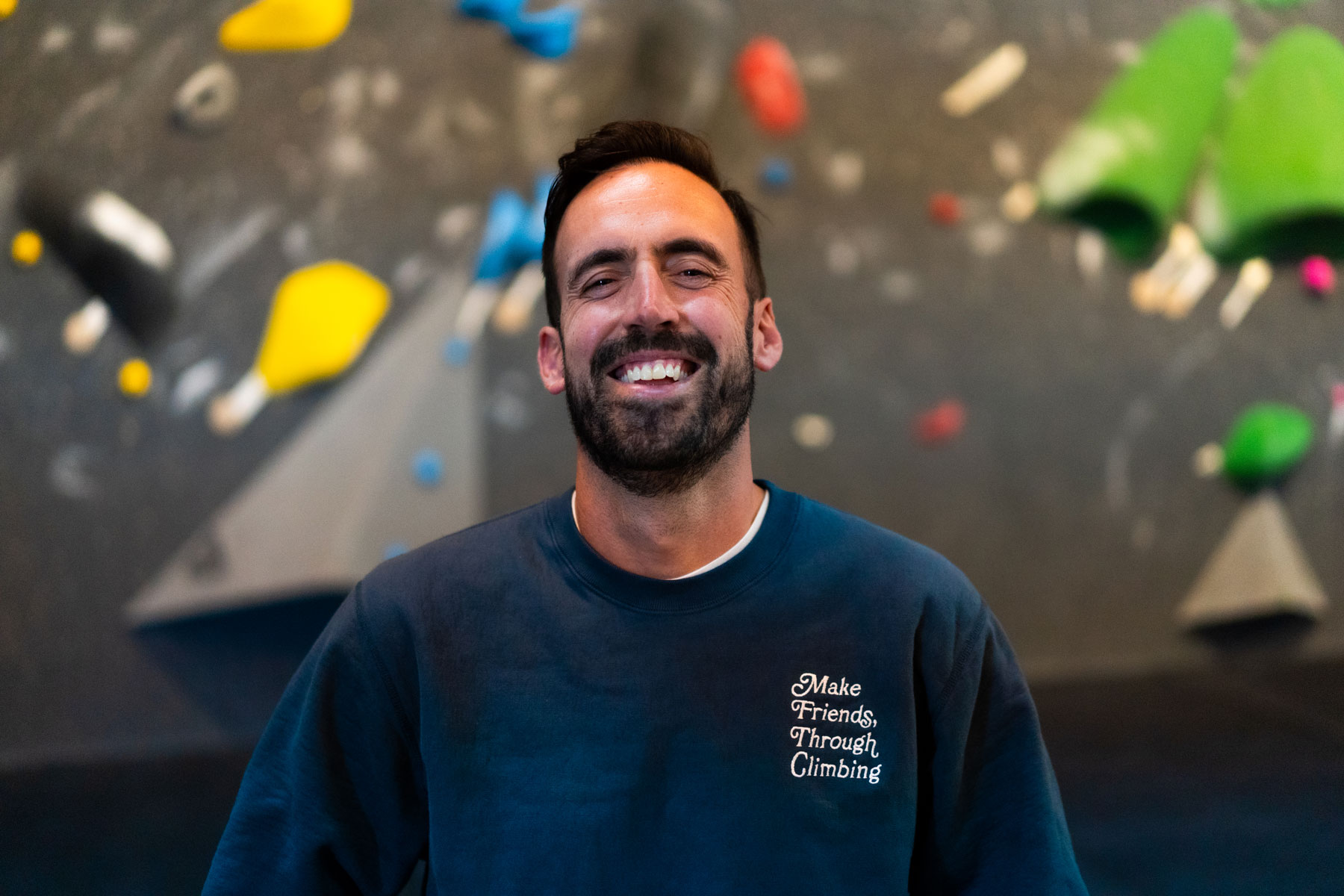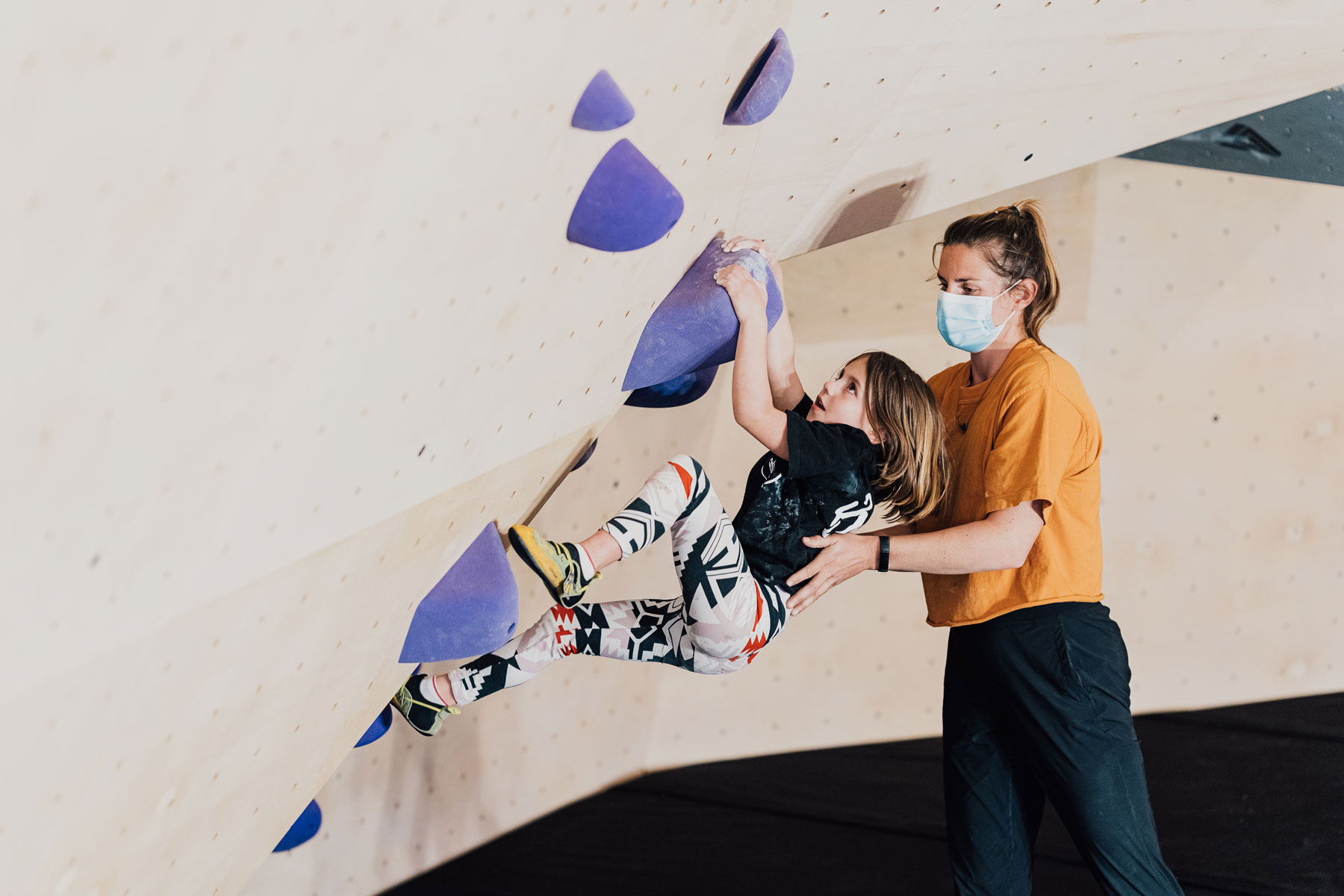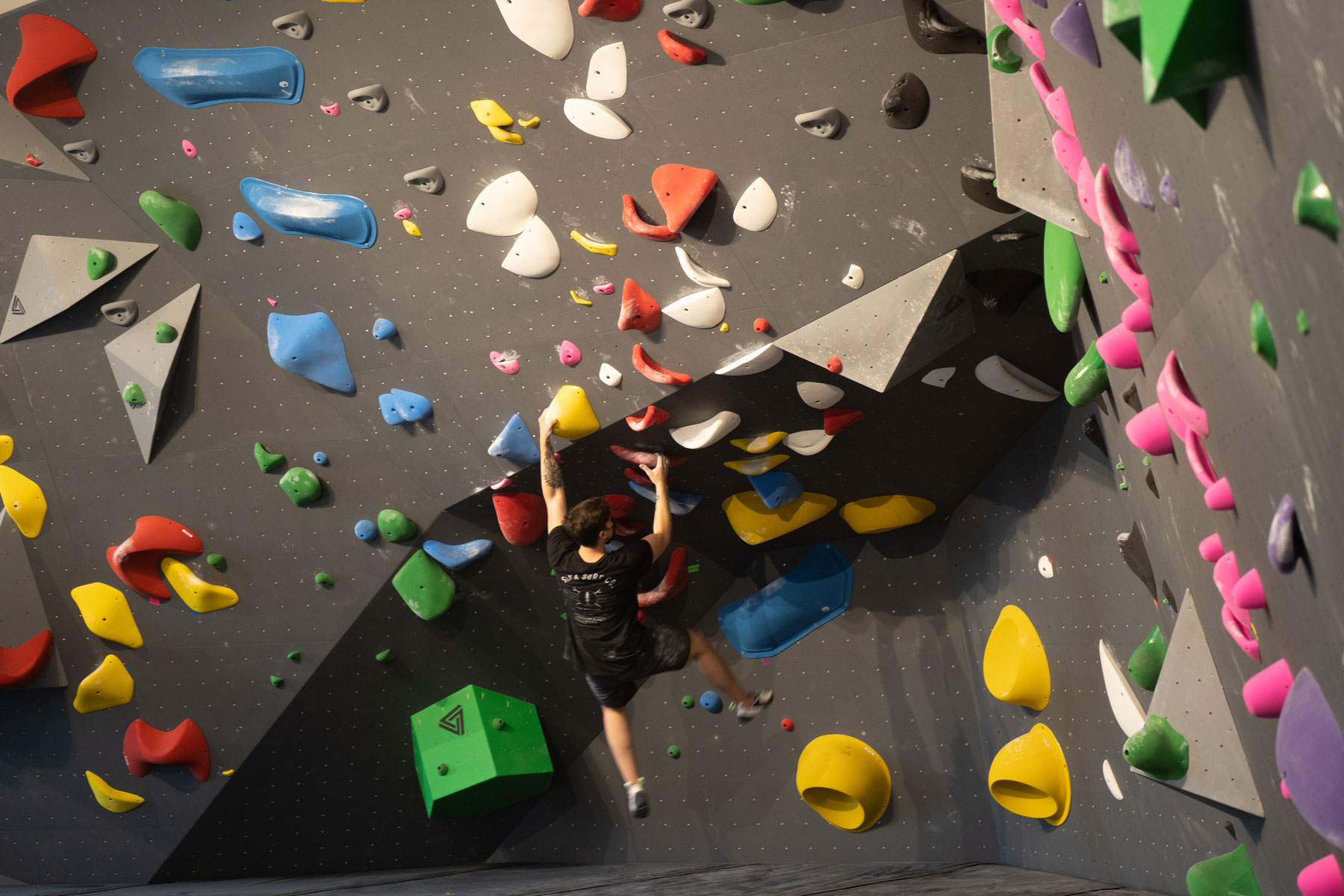
In this episode of the CBJ Podcast, we’re chatting with Jean-Marc de la Plante, who is a business leader in the Canadian climbing gym scene. He owns or co-owns several gyms in Canada under the UPLIFY development banner, which includes three Allez Up gyms (Montreal), two Seven Bays Bouldering gyms (Halifax), two BoulderHouse gyms (Victoria), Up The Bloc (Mississauga), The Rock Oasis and Joe Rockhead’s (Toronto). A developer of facilities spread all throughout the country, de la Plante shares some insights in this interview on what he looks for when considering a new market or region for a gym, the evolution of the climbing gym industry in Canada, and what he appreciates most about climbing and gyms.
Thank you Kilter and Vertical Solutions for your support!
And thank you Devin Dabney for your music!
Timestamps
00:00 – Intro
02:38 – Jean-Marc de la Plante’s comp experience with Chris Sharma
06:01 – His path from comp climber to gym owner
08:28 – Designing a gym with competitions in mind
13:27 – Governing bodies renting gyms?
16:27 – Potential for more training centers in Canada
19:38 – Advantages and challenges of different facility types
26:22 – Finding gym development partners
28:53 – Market assessment
34:47 – Impact of the COVID pandemic
40:38 – Business approach moving forward
42:36 – de la Plante’s “happy place”
45:01 – Closing
Abridged Transcript
BURGMAN: How does a comp climber transition from that to gym developer and gym owner? Can you kind of explain how that all happened for you?
DE LA PLANTE: I wouldn’t necessarily call myself a climbing competitor. I did do some comps, but it really wasn’t my focus. My favorite thing about climbing when I started was being at the gym. I was just a gym rat, basically. I would just go to the gym, and I loved the community just as much as I loved the climbing. I thought that was so cool; coming from other organized sports, it just felt completely different. And just meeting all these super interesting people, from different walks of life—that’s really what drew me in, aside from the climbing itself. And then I got more interested in organizing competitions early on because I wasn’t a super strong athlete myself.
I met Luigi Montilla a few years into working at the gym. He was trying to sell us some of his holds, his Friction Climbing holds—which is a great hold company still around today—and we kind of hit it off. And then he started talking to me about Tour de Bloc, which was this new comp series that he wanted to start, and everything. We sort of got along and started organizing comps together. And then in 2017, we ended up opening Up The Bloc together and then going on to purchase Rockheads and Rock Oasis this year. I think the reason that I transitioned from being, let’s say, a customer to an owner, is I just really fell in love with the community and the way the gym made me feel. When I first walked into the gym, I just felt like there was something special going on. And yeah, we eventually jumped in and decided to buy the gym, and then the rest is history.
…I’ve read that you’ve said a lot of the gyms that you design or that you plan, you do them with competitions in mind. And so, I’m wondering if you can explain a little bit about what that means or, more specifically, what does that entail when you design a gym for competitions?
Well, things are constantly changing, but there was a period in which—I would say five to ten years ago—the competitions that you would host were a big part of what kind of defined, in my opinion at least, your gym and your commitment to climbers of a higher-level…From the first competitions that we organized in the original Allez Up location, we didn’t even have bouldering walls, but we were hosting bouldering competitions by putting up these huge temporary structures and bolting them onto our existing top rope walls just so they could have a steeper angle. So, of course, when it came time to designing our next facilities, I was like, “Well, I don’t want to be bolting on these structures every time I want it set up…” And so, we early on kind of made sure that we weren’t making huge concessions as to the daily operations of the gym, because I don’t think that’s a good idea. You don’t want to plan your gym for that two days a year. You want to plan your gym for the other 363 days of the year. But if there are decisions that you can make that don’t negatively impact the other uses of the gym, then you should make them…

From a gym owner’s perspective, what are the advantages and challenges of each end of the spectrum: the smaller gyms, the bouldering-focused facilities, and the larger facilities with a big footprint, mixed-climbing, ropes, bouldering, auto belays, all of that stuff?
Our model is very different than what I’ve seen elsewhere, and there’s a reason for those things. And I think the way that we approach it is potentially different. When I got into climbing, we didn’t really buy the first facility with an intention of growing the business to the size that it did. It was more like a strong passion for climbing and then feeling that, if we bought the gym, we could make it better and we could surprise people and just take it up a notch in terms of quality and the service that we’re offering and stuff. But then as we were successful, we realized, “Okay, there’s an opportunity to do this again.”
The typical way to look at it is: “What’s our model?” The first Allez Up, when we moved from the original location to the new location in the silos, we had built this thing and it was very successful. And then what normal business people would do is they would say, “Let’s take this model and build another one somewhere else.” And for me, because of where I was coming from with how we approached the purchase of the gym, it was like, “Well wait, we don’t really want that. We don’t want to start a chain of just the same gym here in all different locations.” We really were focused on serving the community and answering the needs of a community. So, we sort of looked around the country and said, “Okay, where are the cities that have good climbing communities, but that community doesn’t really have a home?” There’s maybe a small gym in the suburbs or there’s an older gym that’s not getting the love that it should.
So, we saw an opportunity in Halifax. There was a really strong outdoor bouldering community there, with really good rock quality and lots of climbers. And so, we opened Seven Bays, which was completely different from Allez Up. Allez Up is, like, a 21,000-square-foot facility with 50-foot walls. In Halifax, when we opened Seven Bays, I think the whole wall is, like, 100 linear feet of bouldering, but we had a full café with a liquor license and a kitchen with food and it was just what that community needed. That community needed a place to meet, hang out, train, and so that’s kind of been our approach ever since then: “What does the community need?”
…We’re trying to look at it from checking all the boxes for each community, and that’s different city to city. And that’s also why we have a partnership business model, where in each city we have a local partner who owns a percentage of the company. So, they also have an influence, because we want it to feel local. We don’t want it to feel like somebody from Montreal telling someone from Halifax what climbing should look like. We have a holding company that kind of owns our portion of all of our gyms, but we see ourselves like a bit of a collective of gyms, because the local partners have so much decision power and autonomy. As the [holding company], we try and just support them and take away things off their plate that prevent them from spending time making the facility better…

How do you find and maybe how do you vet or select the local partners that you choose for each different spot?
If we were to pick a partner right now, I think we would have a much better system in place. We definitely went about it sort of rolling with the punches…But what we are looking for is somebody who shares the same values. We’re really passionate climbers, but we also understand that—you know, I met my wife at the gym, and I know so many people who have met their partners at the gym and now their kids are climbing, or climbing has helped them travel the world, or their tightest friend group is still the friend group that they had from the gym ten years ago. The shirt I’m wearing, “make friends through climbing”—these new BoulderHouse shirts that are coming out soon—that’s really kind of our philosophy. So, when we’re choosing a local partner, we’re looking for things like: Are you good at managing people? Are you good at communication? Are you a hardworking person? Let’s face it, running gyms is really hard work. You end up working a lot more than you would if you stayed at your nine-to-five. So, we’re looking for all those things, but really we’re looking for people who understand this and are willing to make business decisions that follow that philosophy.
You said that when you’re going into a new market or considering a new market, you look at places that maybe have a really strong community of climbers, a preexisting community of climbers. Can you explain a little bit about some of the other metrics you mentioned?
…I think to me there are two main things that are pretty obvious, but having an active community, especially if they’re already active in outdoor-type activities, even if it’s not climbing; I think that makes a big difference. But the biggest one for us that we found is universities. University is really when people have the time. Climbing is a sport that requires a lot of investment of time. And university students really are the main sort of target audience, I would say, for climbing gyms. It’s not 100% true because I have seen over the years a shift where the demographic of people who climb on ropes is getting older and the university students are mainly bouldering, but it makes a huge difference. And now, more than ever, public transit—at least in the cities where we’re in. If it’s not accessible by public transit, it’s going to be an uphill battle because people are less and less motivated to drive and parking is a huge problem…

Of all your gyms and all the different, unique walls—the different spaces, the communal sections of the gym, the café—where is your favorite spot? Where’s your happy place?
…Ultimately, I’ve been trying to get better at climbing my entire life, and I have improved. And I would say I’m probably at the highest level that I’ve ever been, which really makes me feel good for a 40-year-old guy. But when I really think of the essence of what keeps me climbing, the climbing is such a small part of it, really. It’s pretty hilarious because I live in Victoria with my wife and kids and, when I go to the gym, I usually go by myself because one of us has to stay home with the kids, right? So, I go to BoulderHouse and I’m climbing and because Rob, our business partner, is the main guy, nobody really knows who I am and I’m just kind of one amongst the members, and I find myself being way more chatty and social. I think of myself as kind of introverted, but when I’m climbing I’m not; I’m really extroverted and I like to talk with people and work on boulders with people I’ve never met before. That’s really my happy place: having a good session with people…

John Burgman is the author of High Drama, a book that chronicles the history of American competition climbing. He is a Fulbright journalism grant recipient and a former magazine editor. He holds a master’s degree from New York University and bachelor’s degree from Miami University. In addition to writing, he coaches a youth bouldering team. Follow him on Twitter @John_Burgman and Instagram @jbclimbs. Read our interview Meet John Burgman, U.S. Comp Climbing’s Top Journalist.









